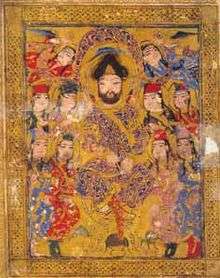Abu al-Faraj al-Isfahani
Ali ibn al-Husayn al-Iṣfahānī (Arabic: أبو الفرج الأصفهاني), also known as Abul-Faraj (897–967 CE) was an historian of Arab-Quraysh origin[1][2] who is noted for collecting and preserving ancient Arabic lyrics and poems in his major work, the Kitāb al-Aghānī. [3]
Abu al-Faraj al-Isfahani | |
|---|---|
 Illustration from Kitab al-aghani (Book of Songs), 1216-20, by Abu al-Faraj al-Isfahani, a collection of songs by famous musicians and Arab poets. | |
| Born | 897 |
| Died | 967 (aged 69–70) |
| Known for | Book of Songs |
| Scientific career | |
| Fields | History |
| Patrons | Sayf ad-Dawlah |
Biography
Abu al-Faraj al-Iṣfahānī was born in Isfahan, Persia (present-day Iran) but spent his youth and made his early studies in Baghdad (present-day Iraq). He was a direct descendant of the last of the Umayyad caliphs, Marwan II,[lower-alpha 1] and was thus connected with the Umayyad rulers in al-Andalus, and seems to have kept up a correspondence with them and to have sent them some of his works. He became famous for his knowledge of early Arabian antiquities.[5]
His later life was spent in various parts of the Islamic world, in Aleppo with its Hamdanid governor Sayf ad-Dawlah (to whom he dedicated the Book of Songs), in Ray with the Buwayhid vizier Ibn 'Abbad, and elsewhere.
Although he wrote poetry, also an anthology of verses on the monasteries of Mesopotamia and Egypt, and a genealogical work, his fame rests upon his Book of Songs (Kitab al-Aghani).[5]
Book of Songs & Other Works
- Kitāb al-Aġānī (كتاب الأغاني) 'Book of Songs', a collection of Arabic chants rich in information on Arab and Persian poets, singers and other musicians from the 7th - 10th centuries of major cities such as Mecca, Damascus, Isfahan, Rey, Baghdād and Baṣrah. The Book of Songs contains details of the ancient Arab tribes and courtly life of the Umayyads and provides a complete overview of the Arab civilization from the pre-Islamic Jahiliyya era, up to his own time.[6][7] Abū ‘l-Faraj employs the classical Arabic genealogical devise, or isnad, (chain of transmission), to relate the biographical accounts of the authors and composers.[6] Although originally the poems were put to music, the musical signs are no longer legible. Abū ‘l-Faraj spent in total 50 years creating this work, which remains an important historical source.
The first printed edition, published in 1868, contained 20 volumes. In 1888 Rudolf Ernst Brünnow published a 21st volume being a collection of biographies not contained in the Bulāq edition, edited from MSS in the Royal Library of Munich.[8]
- Maqātil aṭ-Ṭālibīyīn (مقاتل الطالبيين}), Tālibid Fights, a collection of more than 200 biographies of the descendants of Abū Tālib ibn'Abd al-Muttalib, from the time of the Prophet Muḥammad to the writing of the book in 313 the Hijri (= 925/926 CE) who died in an unnatural way. [9]As Abūl-Faraj said in the foreword to his work, he included only those Tālibids who rebelled against the government and were killed, slaughtered, executed or poisoned, lived underground, fled or died in captivity. [10] The work is a major source for the Umayyad and Abbāsid Alid uprisings and the main source for the Hashimite meeting that took place after the assassination of the Umayyad Caliph al-Walīd II in the village of al-Abwā' between Mecca and Medina. At this meeting, al-'Abdallah made the Hashimites pledge an oath of allegiance to his son Muhammad al-Nafs al-Zakiyya as the new Mahdi. [11]
- Kitāb al-Imā'āš-šawā'ir (كتاب الإماء الشواعر) 'The Book of the Poet-slaves', a collection of accounts of poetic slaves of the Abbasid period.
See also
- List of Arab scientists and scholars
- List of Iranian scientists and scholars
Notes
- Al-Isfahani traces his descent to Marwan II as follows: Abu al-Faraj Ali ibn al-Husayn ibn Muhammad ibn Ahmad ibn al-Haytham ibn Abd al-Rahman ibn Marwan ibn Abd Allah ibn Marwan II ibn Muhammad ibn Marwan I.[4]
References
- M. Nallino (1960). "Abu 'l-Faradj al-Isbahani". In Gibb, H. A. R.; Kramers, J. H.; Lévi-Provençal, E.; Schacht, J.; Lewis, B. & Pellat, Ch. (eds.). The Encyclopaedia of Islam, New Edition, Volume I: A–B. Leiden: E. J. Brill. p. 118. OCLC 495469456.
- Bagley, F. R. C. "ABU'L-FARAJ EṢFAHĀNĪ". Encyclopaedia Iranica. Archived from the original on 16 November 2011. Retrieved 2 April 2017.
- Sawa, S.G. (1985), "The Status and Roles of the Secular Musicians in the Kitāb al-Aghānī (Book of Songs) of Abu al-Faraj al-Iṣbahānī", Asian Music, Asian Music, Vol. 17, No. 1, 17 (1): 68–82, doi:10.2307/833741, JSTOR 833741
- De Slane, Mac Guckin (1842). Ibn Khallikan's Biographical Dictionary, Volume 3. Paris: Oriental Translation Fund of Great Britain and Ireland. p. 300.
-

- Al-A'zami, p. 192.
- Chambers Biographical Dictionary, ISBN 0-550-18022-2, page 5
- Brünnow 1888.
- Günther, p. 13.
- Günther, p. 14.
- Nagel, pp. 258–262.
- Al-A'zami, Muhammad Mustafa (2003), The History of The Qur'anic Text: From Revelation to Compilation: A Comparative Study with the Old and New Testaments, UK Islamic Academy, ISBN 978-1872531656
- Abu’l Faraj al-Isfahani (1888), Brünnow, Rudolf-Ernst (ed.), The Twenty-First Volume of Kitāb al-Aġānī; a Collection of Biographies not contained in the edition of Bulāq, Edited from Manuscripts in the Royal Library of Munich, Toronto: Lidin Matba' BrilCS1 maint: ref=harv (link)
- Günther, Sebastian (1991), Quellenuntersuchungen zu den Maqātil aṭ-Ṭālibiyyīn des Abū 'l-Faraǧ al-Iṣfahānī, Hildesheim
- Tilman Nagel (1970). "Ein früher Bericht über den Aufstand von Muḥammad b. ʿAbdallāh im Jahr 145 h". Der Islam (in German) (46 ed.). Cite journal requires
|journal=(help)CS1 maint: ref=harv (link)